St. Ignatius Church, Gorizia
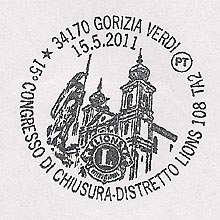
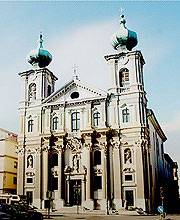
ITALY, 2011, special Lions Congress cancel showing St.
Ignatius Church at Gorizia, Italy.
JESUIT
INSTITUTIONS |
St. Ignatius Church, Gorizia


ITALY, 2011, special Lions Congress cancel showing St.
Ignatius Church at Gorizia, Italy.
Jesuits were invited to Gorizia (Görz), a former part of the Hapsburg Austrian Empire to help stop the spread of Lutheranism. Two Jesuits came there in April 1615 to begin the work, but within a few months the war between Venice and the Hapsburgs interrupted their work until 1620. In 1621 the school, until then subject to the college of Graz, became an independent college. Two advanced courses of studies were later added: that of moral theology (1639) and that of philosophy (1650). Pastoral requirements required the construction of a new church, beginning in 1654, suitable for the large number of faithful who participated. The Jesuits' care wasn't limited to the students, they also founded pious congregations for the nobles and the citizens. The church took more than 80 years to complete, the facade being constructed between 1721 and 1723 by the Austrian Jesuit Christoph Tausch, a student of Br. Andrea Pozzo, SJ. By 1687 the number of students reached 594, the highest in its history. Pastoral and spiritual activity also increased dramatically. While the college was the training site for seminarians in 1723, a decline had begun leading to the failure of major courses in canon law and mathematics. With the erection of the Diocese of Gorizia in 1751, the Jesuits lost the right to name the pastor of the parish church. And while the St. Ignatius Church was finally consecrated in 1767, the Order was already beginning to be suppressed in 1762 in France, in 1767 in the territory of Charles III, and by 1773 throughout the world.
Jesuit
College at Messina
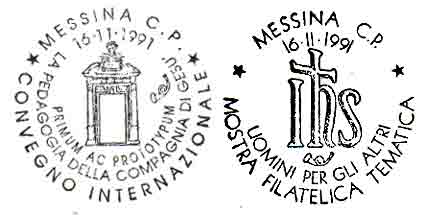
1991, cancels with reference to the Jesuit college at Messina and the 1991
World Congress on Jesuit Education
The college at Messina was the first Jesuit school open to lay men. The World Congress on Jesuit Education took place in Messina in November 1991 as part of the Ignatian Year. Jesuit education at that time involved 1370 educational institutions, in 65 countries, embracing 2,000,000 students and 81,000 teachers.
The Brera College and Observatory, Milan

YUGOSLAVIA, 1987, bicentenary of the death of Roger Boscovich, Scott 1834 perf and imperf
featuring the Brera Observatory founded by him

ITALY, 2012, the 250th anniversary of the Brera Observatory, Scott 3151In 1571 Pope Pius V at the request of Cardinal Charles Borromeo gave the remains of a monastery and the land that once belong to the congregation of the Humiliati, now dissolved, to the Jesuits to set up a college there. In 1572 Pope Gregory XIII issued the Bull, Dum intra mentis nostrae, gave the Jesuit college of Brera rights to award certain university degrees, but to avoid conflict with the nearby University of Pavia and the Senate of Milan which defended Pavia's status, the Jesuits exercised their higher academic privileges cautiously. Meanwhile plans for a new school building, begun in 1573 by Martino Bassi, did not progress until 1627 when Francesco Maria Richini took over the project. In 1764-1765 under Boscovich's instigation the observatory was added. When the Jesuits were dissolved in 1773 the college and observatory became state property. The building now houses the Pinacoteca di Brera, Milan's largest art gallery and one of the most important in Italy, as well as the Academy of Fine Arts of Brera and the Brera Library.
Nunziatella Military School, Naples

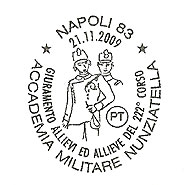

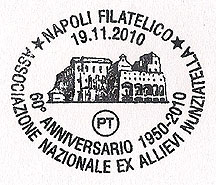
ITALY, 1987, the bicentenary of the Nunziatella
Military School of Naples, Scott 1727
Special cancels for the 222nd anniversary of the Military School "Nunziatella"
on November 21, 2009 and the oath of allegiance to the Republic,
for the 30th reunion of the 193rd class (entering in 1980 and graduating in
the school's bicentennial year),
and for the 60th anniversary in 2010 of the founding of the National Alumni
Association of the school.
The Nunziatella is so named from a chapel on the grounds, "the little chapel of the Annunciation." The noblewoman Anna Mendozza Marchesana della Valle had this built in 1588, and gave it to the Jesuits as their novitiate. After the Suppression of the Jesuits, it entered into other hands, and in 1787 became one of the foremost military academies in Europe.
Istituto Massimiliano Massimo, Rome

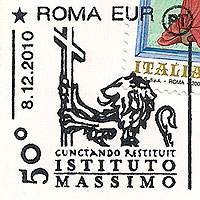
ITALY 2010, special cancel for the 50th anniversary
of the Istituto at E.U.R.
The Massimiliano Massimo Institute (Istituto Massimiliano Massimo) is a Jesuit school in Rome. When the Italian Government in 1870 confiscated the building of the Roman College for the Ennio Quirino Visconti Liceo Ginnasio, the college's professors and students moved to the nearby Palazzo Borromeo until the Pontifical Gregorian University was built to take its university students. However, in 1873, Fr. Massimiliano Massimo, SJ (after whom the institute is now named) inherited the Palazzo Peretti and, in 1879, made it available to the Jesuits for the re-foundation of a school to continue the Roman College's work in secondary education. In 1960, due to a rise in student numbers, the institute was transferred from Terme (near the Stazione Termini) to EUR (Esposizione Universale Roma) a residential and business district in Rome originally planned as the site for the 1942 world's fair.
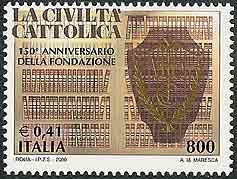
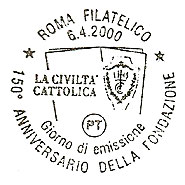
ITALY 2000, the 150th anniversary of its foundation,
Scott 2340, and its FDI cancel
Jesuits today have many publications, but La Civiltà Cattolica, a biweekly publication, is the first of their journals to be published following the Restoration of the Society. La Civiltà Cattolica is read by the Vatican Secretary of State before publication, and so it is considered an indication of the mind of the Vatican on issues the Vatican itself has not yet officially addressed. More
The Pontifical Biblical Institute, Rome

VATICAN CITY, 2009, honoring the Institute on World Book and Copyright Day, Scott 1416
ITALY, 1988, meter stamp for the InstituteThe Pontifical Biblical Institute (P.B.I.) is a university-level institution of the Holy See. It was established by Pope Pius X with the Apostolic Letter of 7 May 1909, Vinea electa, in order to be "a center of higher studies for Sacred Scripture in the city of Rome to promote Biblical doctrine and all related studies according to the spirit of the Catholic Church." From its foundation the institute was entrusted to the Society of Jesus. The main location of the Pontifical Biblical Institute is in Rome, but there is also a branch in Jerusalem, which was started in 1927.

ITALY, 1988, to honor the E. Quirino Visconti School, Scott 1730
The building shown on this stamp has been known for ages as the Roman College, the first and most important educational work of the Society of Jesus. It has long since passed into the hands of the State and has until recently been shared by two entities: the National Library and the Liceo E. Q. Visconti. The books given up by the Society at the time of the Suppression became the nucleus of the National Library of Italy in Rome. The building dates from 1583 to 1585 along with St. Ignatius Church in the same block, once the college chapel. The complex was the gift of Pope Gregory XIII, so that what began as the Roman College took the name of the Pontifical Gregorian University, located in this building until 1870.